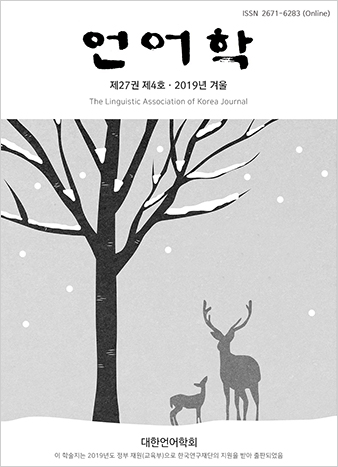대한언어학회 전자저널

-
Anyway as an Unassociative Stance Marker in the American Television Talk Show, Larry King Live
-
Influences of a Native English Teacher and Roles of a Co-teacher on L2 Learners' Learning Styles
-
On the Functions of the Simple Present Tense in The Pilgrim’s Progress
-
Teaching English through Vlogging and In-class Presentation: A Preliminary Comparative Study
27권 4호 (2019년 12월)
- 김정은 시대의 북한 고급중학교 영어교과서 읽기 지문 내용 분석
-
주윤하 · 엄철주
Pages : 21-36
Abstract
Keywords
# 북한 영어교육(North Korea English education) # 북한 고급중학교 영어교과서(North Korean High school English textbook) # 남·북한 영어교육 과정(English National Curriculum in South and North Korea) # 내용 분석(content analysis)
References
- 교육과학기술부. (2015). 영어과 교육과정. 교육과학기술부.
- 김귀석, 이수경. (2009). 영어동화를 활용한 어휘 지도. 영어영문학21, 22(3), 157-186.
- 김단솔. (2017). 북한의 영어교과서 분석: 중학교 1,2,3학년을 중심으로. 석사학위논문, 고려대학교.
- 김명옥, 김혜영, 전원제, 리무일, 박철호. (2014). 고급중학교 2. 평양: 외국문도서출판사.
- 김정렬, 김지영. (2017). 북한 영어 교과서 특성 파악을 위한 코퍼스 구축. 영어영문학, 22(2), 207-232.
- 김정렬, 황서연. (2018). 북한 제1중학교와 남북한 일반중학교 영어교과서 어휘분석. 예술인문사회융합멀티미디어논문지, 8(6), 223-231.
- 김정렬, 황서연. (2018). 북한 제1중학교 영어교과서 코퍼스 기반 어휘 분석. 학습자중심교과교육연구, 18(3), 439-458.
- 김지영, 이제영, 김정렬. (2017). 코퍼스 기반 남북한 영어 교과서 어휘의 공시적 분석. 언어과학, 24(2), 25-56.
- 김지영, 이제영, 김정렬. (2017). 북한 영어 교과서 어휘의 통시적 분석. 한국콘텐츠학회논문지, 17(4), 331-340.
- 김진숙. (2017). 북한의 ‘전반적 12년제 의무교육’에 따른 학제와 교육과정 개편: 평가와 전망 – 새로운 교육강령 시행과 관련하여-. 북한법연구, 17, 363-404.
- 남은주. (2009). 남‧북한 영어교육 실태 비교 연구: 남‧북한 중학교 영어 교과서 분석을 중심으로. 석사학위논문, 고려대학교.
- 박약우, 김진철, 고경석, 박기화, 정국진. (2000). 남북한 중등학교 영어과 교과서 비교분석 연구. 외국어교육, 7(2), 163-194.
- 박약우, 박기화, 김진철, 고경석, 정국진. (2001). 북한 영어 교과서 분석. 서울: 한국문화사.
- 박철호, 오선해, 황철진, 리무일. (2015). 고급중학교 3. 평양: 외국문도서출판사.
- 배제이. (2015). 북한 영어교육 연구 -2000년대의 변화를 중심으로. 박사학위논문, 북한대학원대학교.
- 안지민. (2012). 북한 영어 교과서 분석: 중학교 4,5,6학년 교과서를 중심으로. 석사학위논문, 인하대학교.
- 유명근. (2008). 북한 중학교 전학년 영어교과서 지문연구: 서구문화항목을 중심으로. 석사학위논문, 아주대학교.
- 유희연, 김정렬. (2019). 북한 2013 교육과정 개정 전·후 영어교과서 코퍼스 기반 비교: 고급 중학교를 중심으로. 학습자중심교과교육연구, 19(2), 603-622.
- 이나리. (2011). 북한 영어교과서 분석: 고등중학교 3‧4‧5학년 중심으로. 석사학위논문, 건국대학교.
- 이병민, 양현권, 권오현. (2005). 북한 영어교육의 실상. 외국어교육, 12(4), 267-297.
- 이율희. (2015). 북한 일반 중등학교와 영재 중등학교 영어 교과서의 문화 내용 비교 분석. 석사학위논문, 서강대학교.
- 이재원. (2014). 2000년대 이후 북한 영어교과서 변화 연구: 중학교 1,2학년 영어교과서 중심으로. 석사학위논문, 경북대학교.
- 이현주. (2015). 탈북 학생들의 영어교육 증진 방안 연구: 영어교육 현장의 실제와 개선방향. 현대영어교육, 16(3), 231-250.
- 이효선. (2017). 남·북한 중학교 영어과 교육과정 및 교과서 비교 분석: 중학교 1학년을 중심으로. 석사학위논문, 연세대학교.
- 정소영. (2010). 북한 중학교 영어 교과서 분석. 석사학위논문, 북한대학원대학교.
- 정채관, 조정아. (2017). 김정은 체제 북한 중학교 교육과정 연구: 총론과 영어과 교육과정을 중심으로. 외국학연구, 39, 147-166.
- 정채관. (2018). 남북한 공통 영어과 교육과정 개발 연구. 외국어교육연구, 32(4), 47-82.
- 조규희. (2013). 개작 영어동화를 활용한 어휘 중심 초등 영어수업의 효과 연구. 초등영어교육, 19(4), 215-248.
- 조정아, 이교덕, 강호제, 정채관. (2015). 김정은 시대의 북한의 교육정책, 교육과정, 교과서. 통일연구원 연구총서.
- 조정아. (2016). 김정은시대 북한의 교육정책. 월간북한, 90-95.
- 최죽송, 박철호, 오선해, 황철진. (2013). 고급중학교 1. 평양: 외국문도서출판사.
- 통일부 통일교육원. (2014). 북한이해. 서울: 통일교육원 교육개발과.
- 하수지, 박기화. (2017). 어휘 학습전략을 활용한 영어 동화 수준별 수업이 초등학생의 영어 읽기 능력에 미치는 영향. 초등영어교육, 23(2), 143-169.
- 홍명의, 허근. (2011). 인터넷 영어동화를 활용한 초등영어 읽기지도방안에 관한 연구. 현대영어영문학, 55(1), 227-254.
- 홍정실, 김정렬. (2019). 북한 영어교과서의 통치 권력별 통시적 분석. 학습자중심교과교육연구, 19(6), 599-619.
- 황서연, 김정렬. (2017). 북한 제1중학교 영어교과서 분석. 한국콘텐츠학회논문지, 17(11), 242-251.
- 황선희, 김지영. (2017). 영어 동화를 활용한 과업 기반 만들기 활동이 유아의 어휘학습, 어휘기억, 흥미도에 미치는 영향. 영어어문교육, 23(2), 103-130.
- Dornyei, Z. (1994) Motivation and motivating in the foreign language classroom. The Modern Language Journal, 78, 273-284.
- Dubin, F., & Olshtain, E. (1986) Course design: Developing programs and materials for language learning. New York: Cambridge University Press.
- Dulay, H., Burt, M., & Krashen, S. (1982) Language two. Oxford: Oxford University Press.
- Fein, D., & Baldwin, R. (1986) Content-Based curriculum design in advanced levels of an intensive ESL program. TESOL Newsletter, 4(1), 1-3.